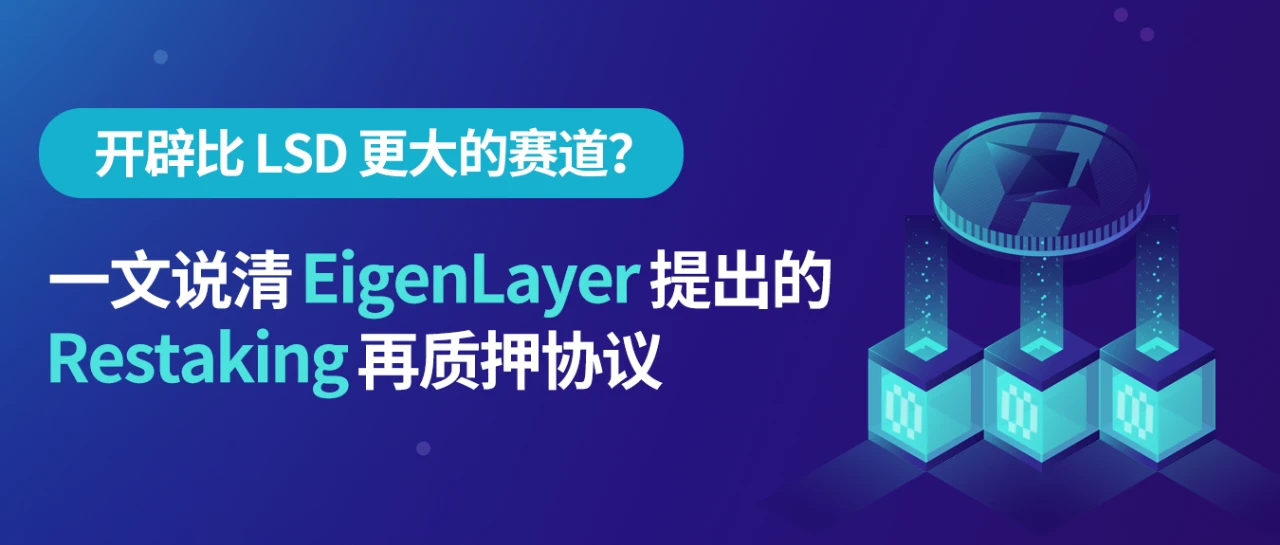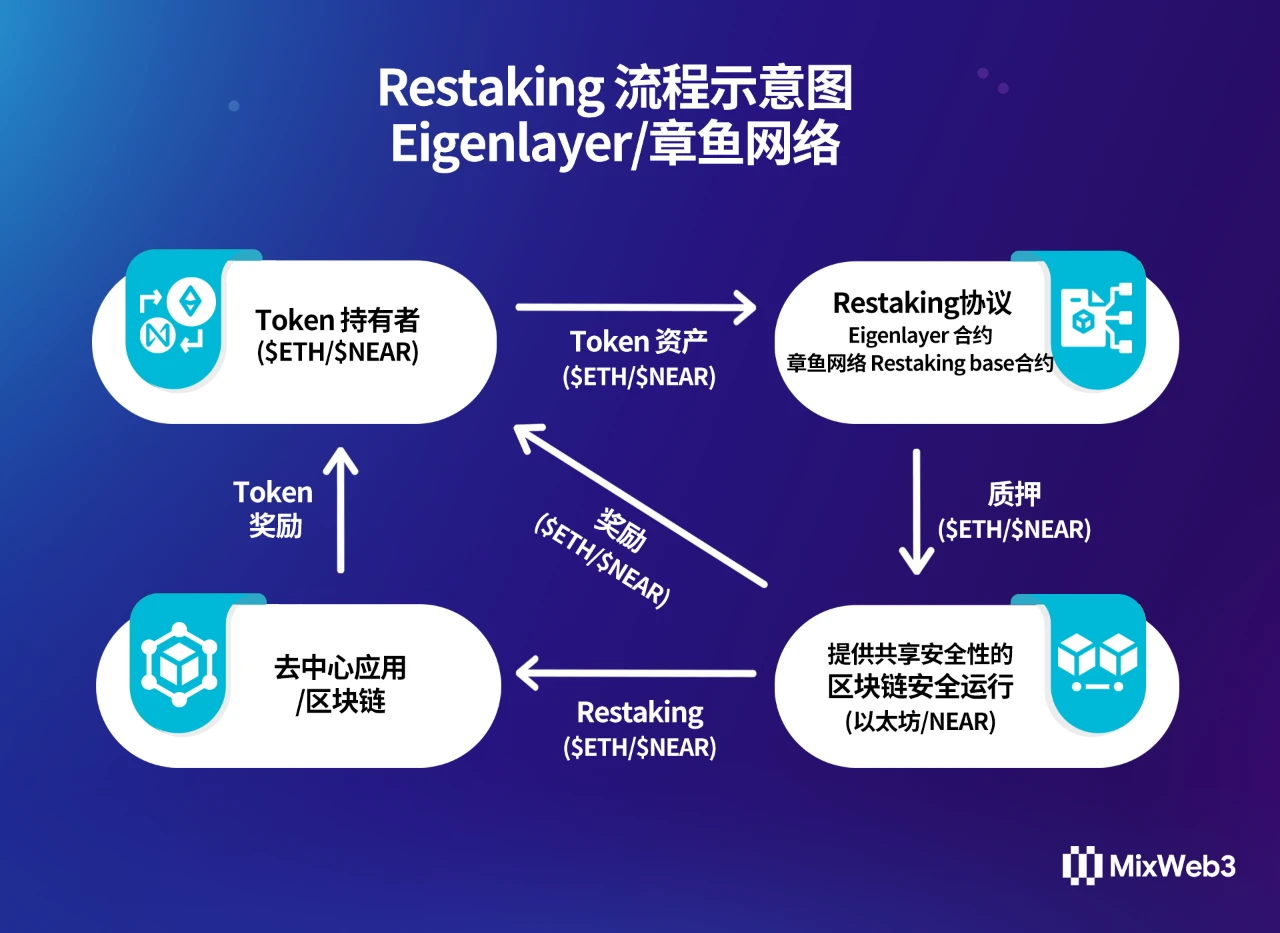Original author: Mix Web3
The Restaking protocol has made Eigenlayer the most popular infrastructure project in Ethereum at the moment. The core team EigenLabs received US$50 million in financing, led by Blockchain Capital, with participation from well-known VCs in the industry such as Coinbase Ventures, Polychain Capital, Bixin Ventures, and Hack VC.
According to the official tweet on May 2, the first phase of EigenLayer’s mainnet will be launched soon and will support Liquid Restaking and Native Restaking. EigenLayer hopes that by introducing the Restaking service, it will provide additional staking opportunities for ETH holders who choose to join, and promote project innovation in the Ethereum ecosystem by reducing the security cost of AVS.
I have to say that Restaking has once again verifiedWeb3 composabilityof strength.

What is Restaking?
Restaking was first proposed by Eigenlayer founder Sreeram Kannan. Eigenlayer is a decentralized trust market in the Ethereum ecosystem, aiming to expand the trust network of Ethereum. Its core mechanism, Restaking, allows ETH that has been pledged on Ethereum to be pledged again. Let other consensus protocols share the almost unshakable economic security of Ethereum to ensure its safe startup and operation. In addition to ETH pledge rewards, ETH pledgers can also receive Restaking benefits provided by AVS.
In essence, Restaking is a shared security mechanism that allows the same assets to be pledged to multiple decentralized applications/blockchains at the same time to provide them with security.Generally speaking,The new decentralized application/blockchain will choose to join the blockchain ecosystem that is sufficiently secure and compatible with its own project, and will attract pledgers of this blockchain by issuing rewards; pledgers can transfer their pledged The assets are pledged to this new decentralized application/blockchain again, and a reward income is once again obtained.

The so-called shared security allows a blockchain to enhance the security of its own blockchain by sharing the value of another blockchain’s verification node. For example, Polkadot’s “Slot Solution”, Octopus Network’s “LPoS Lease Proof of Equity”, Cosmos’ “Replicated Security”, Avalanche’s “Subnet” and Polygon’s “Supernet” are all players in the shared security field. .
Just a few months after Eigenlayer proposed the concept of Restaking,NEAR ecological leading infrastructure project Octopus Network announced the follow-up Restaking service. Octopus Network allows holders of $NEAR to restake for the application chain while staking the NEAR public chain, providing security to obtain the staking rewards provided by the application chain.
I believe that other Layer 1 public chain Restaking projects are also in the pipeline. If there is an official announcement of the project, the author will research and share it as soon as possible.
Why is Restaking so highly anticipated?
As the narrative of multi-chain networks and application chains gradually becomes more and more popular, it has become particularly important to provide lower-cost and more decentralized shared security services for the safe startup and operation of blockchains.
Usually in various types of shared security solutions,There are three key stakeholders, namely decentralized applications/blockchains, blockchains that provide shared security and pledgers. The Restaking mechanism not only maximizes the interests of the three, but also interests are completely unified.
1. Decentralized applications/blockchain
If you want to achieve safe startup and operation of decentralized applications/blockchains represented by middleware chains and application chains by building your own verification node network, you will need to pay extremely high economic and time costs.
Choose the Restaking plan because decentralized applications/blockchains will first join a blockchain ecosystem that is sufficiently secure and compatible with its own project. Its community has a large number of pledgers who can serve as security service providers. , it can directly use the security of billions or even tens of billions of dollars it already has.
Decentralized applications/blockchains can flexibly obtain and adjust the pledge amount and security level according to their own security needs at different stages of development through rewards. For example, the security level can be relatively low in the early stages of a project, and can be adjusted to a higher security level through governance as the number of assets increases later.
At the same time, Restaking allows new projects to be more closely bound to the chosen ecology, helping to gain ecological support.
2. Pledger
From a stakers perspective, Restaking is the best choice. In addition to staking the original blockchain and earning rewards, the Restaking mechanism allows the same pledged token to be pledged to other blockchains to provide security, thereby obtaining another security reward.
The compound income brought by Restaking is the most capital-efficient staking method at the moment.
Gabriel Haines used a magical 7-second video to succinctly describe Restaking’s huge appeal to stakers: “You take your staked ETH… and you stake it again ).

3. Blockchain that provides shared security
Blockchains that provide shared security are usually Layer 1 public chains based on PoS.
First of all, Restaking solves the problem that the original encryption economic security of the blockchain is difficult to transfer and expand to other ecological protocols.: For example, Ethereum is the blockchain with the highest security level, but the security level of various middleware protocols in its ecosystem is significantly lower than that of Ethereum.
Secondly, Restaking creates more economic value for pledged tokens, and the scale of the blockchain token pledge market will be greatly expanded.The value ceiling of pledged tokens has been increased unprecedentedly.
With the gradual increase of Restaking projects, the blockchain that provides shared security will surely become the hub blockchain with the highest security, the most pledgers, the most application layer protocols, the most Web3 users, and the most encrypted assets in the entire ecosystem.The feedback effect of the Restaking project further enhances the economic security and value capture capabilities of the blockchain.
The best part is that blockchain provides shared security at no additional cost.
The growth flywheel built by Restaking
Each decentralized application/blockchain using Restaking is like a bond market, with different levels of productivity and yield. Part of its value will continue to flow to the blockchain ecosystem and be converted into the added value of pledged tokens.
The use of Restaking by stakers brings higher returns, which not only increases the value of the pledged tokens, but also stimulates the motivation to continue staking. When stakers reinvest these earnings into the pledge pool, the entire Restaking shared security model forms a logical closed loop of a value growth flywheel.

Of course, as an emerging thing, Restaking also has various potential risks, such as possible centralization risks, risks caused by high leverage, cross-domain MEV and how to establish a censorship market, which requires continuous innovation. Complete.
I will discuss this in subsequent Restaking series articles.
Disclaimer: This article is for informational purposes only and may not be relied upon as legal, tax, investment, financial, or any other advice.










